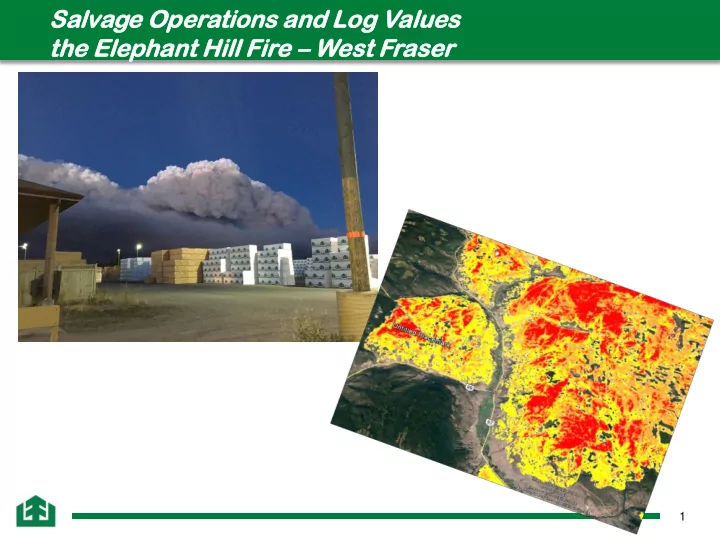

Salvage e Op Oper erations tions and Log g Values ues the e Elephant hant Hill Fire e – West st Fraser aser 1
Approach Guidance and Supporting Information 1. Summary of Ongoing Work – Values Assessments and Related Information to Support Wildfire recovery Planning – EHF – MFLNRORD. Dec 2017. 2. Post-Wildfire Salvage Guidance to Licensees – MFLNRORD. Sept 2017. 3. West Fraser Recovery Strategy for Damaged Timber in Wildfires – EHF. Oct 2017. 4. Post-Natural Disturbance Forest Retention Guidance – Chief Forester. Jan 2018. 5. Post-Wildfire Hydrologic Concerns and Recommendations for Salvage Logging in the Southern Interior – Rita Winkler. Feb 2018. 6. Timber Salvage Principles for Elephant Hill Wildfire – Joint Leadership Council. Feb 2018 7. Post-Wildfire Salvage Expectations for Land use Designations in Cariboo Region – MFLNRORD – Cariboo Region. Feb 2018. 8. Silviculture and Reforestation Principles for Elephant Hill Wildfire - Joint Leadership Council. July 2018. 2
Approach Guidance and Expectations 1. Landscape Level OGMA, R & P Visual, WTRA, etc. Slopes >30% Hydrologically and riparian sensitive zones. Focus on retention – Retain live/green trees. Excluding harvest in light-mod burn areas 2. Stand Level Extensive riparian and hydric/Sub-hydric area retention. Archaeological and cultural heritage retention. Individual and patch tree retention (both dead and live). 3. Timing Estimated 3 year shelf life. 3
Fire Intensity 4
Stand and Tree Assessment – Quality depends on tree species and fire intensity – Primarily IDF stands with past logging history – Low volume/ha, low stems/ha – Small piece size – Sx little to no sawlog value, Pl burned up 5
Development Challenges – Hydrological and geomorphological concerns – Extensive archaeological concerns – Access and road infrastructure concerns – Harvest and road building challenges – Silvicultural concerns Higher planning costs Higher road costs Higher logging costs Higher post harvest obligation costs 6
7
8
Manufacturing Challenges • Log yard – minimize yard time • Blended log runs / straight burn run 9
Manufacturing Challenges • Mill upgrades – de-barker, dust control • De-barker slows to ensure complete debarking • Chip production - contribute to local pulp facilities. • Thus far, quality has been as expected • Expect more end checks this spring/summer • Expect greater overall checking by fall/summer 10
Summary Severely impacted landscapes Greater expectations for fire salvage and recovery Broader considerations Costly 11
Recommend
More recommend